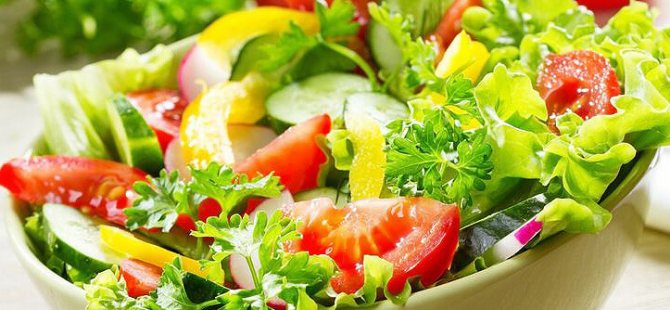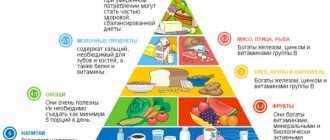In this article we will tell you:
- The concept of rational nutrition
- Basics of rational nutrition
- Rules for rational nutrition
- Rational diet
- Children's nutrition
- Rational nutrition standards
- Energy value of food
- Recommendations for a balanced diet
It has long been known that the primary role in ensuring the quality of our life is not played by genetics (although its influence, undoubtedly, cannot be denied), but rather by our image and style of behavior, as well as eating habits. Not only the functioning of our single integral system called the body, but also the health of subsequent generations will largely depend on how we eat.
Reproductive, hormonal, digestive - there are still no systems on which diet would not have a significant impact: just as the hands of a dial describe the same circles, so everything invariably revolves around what we put in our diet and in what quantity. mouth.
But how not to force yourself into the framework of prohibitions and conventions - in fact, do those same standards of healthy eating exist? How not to chop wood on the way to creating a rational diet and, instead of the expected super effect in the form of toned, elastic skin, beautiful relief and the absence of fatty spaniel ears hanging from the sides, not to aggravate existing problems? Let's figure it out.
The concept of rational nutrition
Balanced diet
- This is not a simple diet balanced in micro- and macronutrients. This is a complete diet that satisfies all the body’s energy needs, tailored to meet age and gender characteristics, the presence of chronic or concomitant diseases, genetic disorders and enzymopathies.
This concept cannot be specified - it always remains purely individual in relation to each person. After all, what is “rational” for one patient may not only not be suitable, but also be extremely dangerous for another: for example, although a 3-times-a-day diet is considered the most physiological, it is fundamentally unsuitable for a patient with adrenal depletion, not not to mention the extreme manifestation of this condition - Addison's disease.
In addition, genetics is also important: for example, the presence of defects in the genes of the folate cycle entails a violation of the utilization of the well-known and quite sensational amino acid homocysteine - and such people are advised to limit animal products containing a precursor in the reactions of its synthesis.
On the other hand, a purely plant-based diet is also contraindicated in case of polymorphisms in other genes - in this situation, vegetarians and vegans are at risk not only for vitamin B12 deficiency, but also for many others. So, say, if the transition of carotene, a precursor of vitamin A, which is concentrated in plant products, is disrupted, you can eat a kilogram of carrots - but this will be of little use (at least in the context of the formation of retinol).
How to organize a balanced diet
The principles of organizing rational nutrition involve taking into account the needs of a particular person in consuming a certain amount of nutrients. The theory of a balanced diet presupposes general rules that should be followed by everyone:
- No overeating. A person must find out the required caloric content of food consumed daily and stick to it, avoiding significant excesses.
- A varied diet, that is, eating dishes of different composition. Avoiding monotony in food, eating a limited set of the same foods every day.
- Consume adequate protein from lean meats, poultry, fish and eggs. Eating plant protein from legumes and nuts is also important.
- Getting enough vitamins and minerals from food. This is achieved by choosing healthy products that contain the necessary substances in sufficient quantities and in the right combinations.
- Maximum reduction in consumption of foods that are more harmful than nutritional value. This includes all products that contain refined sugar and white wheat flour.
These rules contain the basics of rational nutrition. Why do you need to know and adhere to them?
Basics of rational nutrition
And yet we will have to start with theory: after all, it is important to understand not only what we eat, but also for what purpose we do it.
There must be balance in all processes of our body - after all, it is towards internal homeostasis that it so tirelessly strives throughout its life. Let's call this a lever or driving force, which forces the activation of the synthesis of certain hormones and at the same time reduce the formation of others (for example, with an increase in the concentration of glucose in the blood, insulin is actively produced by the beta cells of the pancreas, while the conductor coordinating this hectic metabolic orchestra sends a clear signal: stop glucagon production). Entering the body, crossing its borders in the form of barriers of the skin and mucous membranes stimulates a reciprocal immune response - and all because our smart body, in fact, craves one main goal: peace and order on its vascular streets with parenchymal houses.
Nutrition is no exception.
— the rule of balance is unchanged for him. We eat in order to live (although statistics in recent years indicate a completely opposite trend of interpretation) - in other words, the amount of incoming food products, which, after splitting and digestion, are burned in the furnaces of cells, forming energy, must fully satisfy the body’s expenses, and they really huge.
Few people have thought that most processes, no matter how disadvantageous it is for the body, occur with a loss of energy - even such a primitive mechanism as the transport of glucose, perhaps the most common nutrient: given the large size of its molecule, it simply will not pass through the cage gate, getting stuck in the doorway. Unfortunately, this carbohydrate cannot carry out its functions in the blood - therefore, specific carriers come to the rescue, carrying or transporting it into the cells on their shoulders, thereby providing them with the necessary raw materials.
Fat-soluble substances and gases can freely penetrate through the lipid layer of the membrane - but we cannot eat only them! So, energy is the basis of everything.
However, what will happen if we receive more energy than we are able to expend? Considering the greed of our body and its desire to accumulate (who knows when that very rainy day will come), the balance will invariably be shifted - the so-called positive energy balance develops. And then everything follows the well-worn scenario: depositing fatty tissue as a safety net in case of an apocalypse.
The balance of nutrients is no less important: in classical dietetics the following ratio is given for proteins, fats and carbohydrates - 1: 1: 4. Although, we emphasize: in many ways, these numbers will depend on age and the chosen diet.
The diet should be varied
: mono-diets are a thing of the past. The more sources of nutrients, vitamins and minerals, the more likely it is that the body will be in minimal deficiency states. Turn your plates into a rainbow of colors - typically brightly colored fruits and vegetables are not only a great source of fibre, but also contain quite a bit of antioxidants. In addition, digestion begins even before the first bite enters the oral cavity and the subsequent irritation of the taste buds: that is why the appearance of the dish, its smell and table setting are so important. The complex reflex phase of secretion is the initial link that should not be excluded from the chain of digestion and absorption.
Drink enough water
- no matter how banal this rule may sound, in practice it turns out that many happily neglect it. Water is the basis of life: most digestive secretions consist of more than 97% of it. In the composition of blood plasma, water accounts for 91 to 93% - impressive, right?
Often, restriction in water consumption is motivated by the occurrence of edema. Here it is important to dig deeper and find the main reason for their appearance: and it is clearly not connected (directly so exactly) with water. Pay attention to possible endocrine pathologies - in particular, the functioning of the thyroid gland and adrenal glands. Sometimes the cause is disorders of the cardiovascular system.
Try to drink at least one glass immediately after waking up - and then just start brewing coffee. Moreover, its temperature should be equal to room temperature - remember that excessively cold temperatures can sufficiently cause spasms and generally disrupt the functioning of the gastrointestinal tract.
An approximate formula for calculating the daily water requirement:
Weight (in kg) *30 (ml)
Rational (nutritious) nutrition and conditions for its provision
Rational nutrition is nutrition that is complete in quantity and balanced in quality, which ensures normal growth, physical and psychophysiological development of the body, its high performance, active longevity and resistance to adverse natural, man-made, and social environmental factors.
A balanced diet should meet the following basic principles:
1. To be complete in quantitative terms, that is, in terms of energy value (calorie content) of the daily diet, it corresponds to the energy expenditure of the body, taking into account the part of the diet that is not digestible.
2. Ensure the qualitative completeness (balance) of the diet, that is, the optimal content of all nutrients in it in optimal quantities and ratios - proteins, fats (including animals), carbohydrates (including sugars, fiber, dietary fiber), vitamins, macro-, microelements, flavoring substances.
3. Adhere to a rational diet: the hours of eating should correspond to the biological rhythms of the body; the number of meals should be 3-4 times for adults, 5-6 times for children, depending on age; The intervals between meals should be 5-6 hours for adults and 3-4 hours for children. The distribution of the daily diet into individual meals should meet the physiological needs of the body: in the morning and lunch (the period of physical activity of the body), the energy value should be 30-35% and 45-50%, respectively, at the end of the active period of the day in the evening - 20-25% .
4. Prepared food must meet the enzyme capabilities of the digestive system. To this end, the preparation of products and their culinary processing must ensure good taste, high nutritional value, digestibility and high digestibility of food.
5. Food must be harmless in toxic terms, that is, products and ready-made meals should not contain toxic substances in concentrations harmful to the body.
6. Food must be safe in an epidemic sense: it must be free of pathogens of infectious diseases with a nutritional transmission mechanism - bacteria, viruses, fungi, protozoa, germs of geo- and biohelminths.
Violation of each of these principles can lead to a decrease in the level of health of an individual or an organized group, and the occurrence of diseases of nutritional origin.
Among these diseases are the following:
- diseases associated with starvation, quantitative and qualitative malnutrition (marasmus, kwashiorkor, hypovitaminosis, vitamin deficiency and others);
- diseases associated with overeating (obesity, gout, hepatitis, cholecystitis, pancreatitis, gallstone disease and others);
- diseases associated with poor diet (gastritis, stomach ulcers, duodenal ulcers, coprostasis and others);
- diseases associated with impaired culinary processing of products (gastritis, peptic ulcer, hypovitaminosis and others);
- food poisoning: microbial nature (toxic infections, bacterial toxicoses, mycotoxicosis), non-microbial etiology (products that are toxic by nature; products that have become toxic as a result of violation of storage rules; products contaminated with toxic substances (pesticides, salts of heavy metals and others) ;
— intestinal bacterial, viral, zoonotic infections (typhoid fever, paratyphoid A, B, dysentery; hepatitis A, polio, enteroviruses; brucellosis, foot-and-mouth disease, tuberculosis and others); geo- and biohelminthiases (roundworms, whipworm, bovine tapeworm, pork tapeworm, trichinella, fish tapeworm, flukes and others);
- damage by products contaminated with means of mass destruction in modern warfare - radioactive products of nuclear explosions (RW), chemical warfare agents (CWA), especially dangerous bacterial agents (BS).

This makes clear the need for constant medical monitoring of the nutritional adequacy and safety of both individuals and organized groups.
Among the methods of such control are:
— study and assessment of the nutritional status of controlled people;
— detection of nutritional diseases;
— determination or calculation of energy costs and nutrient requirements;
- assessment of actual nutrition using questionnaires, budgetary, weight, laboratory methods, calculation methods for assessing the calorie content and nutrient composition of the daily diet.
Appendix 2
Rational diet
- Breakfast is everything.
Your first meal should be balanced, rich in fat and protein - this combination will make you full, and you won't even remember about food until lunch.
At the same time, the usual cereals, fruit juices, croissants and other confectionery products, except for another nuclear attack against the cells of the pancreas, will bring neither benefit nor saturation. In a word, a complete sugar bomb.
We recommend
“Balanced nutrition: the right diet and the right foods” Read more
We recommend considering the options for keto breakfasts: they ideally satisfy the feeling of hunger and do not just pickle the worm, but actually put it into a state of suspended animation. Use avocado, bacon, olives, cod liver, and eggs, salmon or poultry are great sources of protein. Add unsweetened coffee or cocoa and a small cup of your favorite berries - and you are guaranteed a stable emotional background, the key to which is the absence of hypoglycemia swings.
- Forget about the existence of the food pyramid
- at least until it is revised. Or better yet, create a new one!
What do you think occupies a dominant position in the old one? Surprisingly, these are grain crops.
Undoubtedly, the same cereals have many useful properties, but let's be honest: in the realities of the modern world, people are surrounded (literally) by their abundance. Take the same wheat (or rather its proteins - gliadins, which, together with other proteins similar in structure and functions, are united under the general name “gluten”) - wherever its components are added - the spectrum has long ceased to be limited to bakery products. The widespread use of gluten has also led to a predictable result: more and more, various groups of the population are diagnosed with gluten hypersensitivity - both in adults and in children.

Food hygiene, that branch of science that a priori should move ahead along with various advanced technologies, is stuck in a deep and very ancient hole of the past. But the responsibility for your health still lies not so much on the shoulders of science, but on your own.
- Fractional meals
- the same outdated regime, applicable only to professional athletes and in a number of diseases. A healthy person, and even more so a person striving with all his might to lose weight, should completely forget about snacks - as an adaptation during a smooth transition, you can leave one, but with the condition that it will be fatty.
- Avoid eating fruit as a meal on its own
— the fructose they contain bypasses all saturation pathways (this is achieved, in particular, due to the absence of a response signal to its entry in the form of insulin secretion from the pancreas). That is why it will not only not dull the feeling of hunger, but, like a match falling on a stack of dry firewood, will make it flare up with even greater force.
- Try to eat at certain times
- again, the digestion process does not rely on purely mechanical rubbing and absorption of food in the gastrointestinal tract.
MALNUTRITION IN THE PATIENT: diagnosis and treatment
Is malnutrition a medical condition? How to determine the severity of malnutrition? What is kwashiorkor? What treatment should be given to a patient with malnutrition?
Malnutrition is still not considered to be a serious disorder that requires timely recognition and active action by a doctor.
Undernutrition is understood as a pathological condition caused by a discrepancy between the intake and consumption of nutrients, leading to a decrease in body weight and a change in the component composition of the body.
Malnutrition is one of the most common disorders observed in patients undergoing treatment for various diseases (see Table 1).
Inadequate nutrition is not only accompanied by weight loss, decreased physical performance, and deterioration in health, but also causes serious metabolic disorders, weakened immune defenses, and endocrine dysfunction [1, 2]. In particular, in surgical patients, malnutrition leads to a significant increase in the incidence of postoperative complications and deaths. According to American surgeons Mullen and Buzby (1980), in patients who underwent gastrectomy, insufficient nutrition increased the incidence of complications by five and seven times, and mortality by 11 times [3].
The causes of malnutrition in patients (see Table 2) can be both external factors (poor nutrition, injury, infections) and internal factors (impaired digestion, absorption and assimilation of nutrients in the body).
To identify cases of malnutrition in patients, somatometric and clinical laboratory parameters are determined. Somatometric indicators include: dynamics of body weight, body mass index, shoulder circumference, thickness of skin-fat folds, body fat content. Currently, during a screening examination of patients, it is customary to measure the circumference of the middle third of the shoulder of the non-working arm (characterizes muscle reserves) and the thickness of the skin-fat fold above the triceps along the back surface of the shoulder using an adipometer caliper (characterizes the body’s fat reserves). The assessment of somatometric indicators of undernutrition is presented in Table 3.
Using clinical and laboratory indicators, the severity of malnutrition is clarified. In addition, blood protein levels indirectly reflect the state of internal organs, since when the reserve pool of blood proteins is depleted, it is replenished by visceral protein. Clinical and laboratory indicators of malnutrition include: the content of total protein, albumin, transferrin in the blood serum, the absolute number of lymphocytes in the peripheral blood (see Table 4).
Given the large number of indicators characterizing malnutrition, scientists have developed various indices that allow for an integrative (total) assessment of the patient's nutritional status. Abroad they use “prognostic nutritional index”, “subjective global assessment”, “nutritional risk index”, etc.
We developed and proposed in 1998 a “prognostic index of malnutrition”, calculated by the formula: 140 - 1.5 (A) - 1 (OP) - 0.5 (KZhST) - 20 (L) where A is the blood albumin content (g/l); OP—shoulder circumference (cm); CLST—thickness of the fold above the triceps (mm); L - absolute number of lymphocytes (109/l).
When this index is less than 20, there are no signs of malnutrition (nutrition is not impaired). With values from 20 to 30, mild malnutrition (hypotrophy) is determined, from 30 to 50 - moderate, above 50 - severe.
A number of studies have shown that with moderate and severe malnutrition, the risk of complications and mortality increases significantly [4, 5].
Malnutrition can manifest itself in two main clinical forms. With long-term progressive, chronic malnutrition (for example, with cancer), there is a decrease in body weight, its muscle and fat components with relatively stable levels of total protein, albumin, and transferrin in the blood. This type of malnutrition is defined as cachexia.
Rapidly developing, acute malnutrition is characterized by a decrease in blood proteins (albumin, transferrin) with minor changes in body weight and the component composition of the body. Such processes develop in the early period after severe injuries, burns, and extensive surgical interventions. This condition is defined as kwashiorkor and can occur in both edematous and non-edematous forms.
Treatment of malnutrition involves three main principles:
- timeliness (therapy should be started as early as possible, avoiding the development of severe exhaustion, which is difficult to treat);
- adequacy (nutrients entering the patient’s body must compensate for all the body’s costs);
- optimality (therapy should be continued until somatometric and clinical laboratory parameters are completely normalized).
To determine the body's actual needs for nutrients and energy, these indicators must be calculated individually, taking into account body weight and the severity of malnutrition (see Table 5).
| Table 5. The body's daily needs for nutrients and energy (per 1 kg of actual body weight). |
For example, a moderately malnourished patient with an actual body weight of 50 kg requires 100 g of protein, 100 g of fat, 300 g of carbohydrates and 2500 kcal per day.
Treatment of malnutrition involves prescribing an enhanced diet, as well as special mixtures for enteral and parenteral nutrition. The diet should contain an increased amount of easily digestible proteins, have sufficient energy value, and be enriched with macro- and microelements and vitamins. Practical experience shows that the choice of food products with these properties is very limited. In recent years, in our country and abroad, balanced nutritional mixtures have been widely used to enrich the diet with easily digestible proteins and other nutrients (see Table 6).
The administration of nutritional mixtures in a dose of 100 to 200 g per day against the background of the main therapeutic diet makes it possible to cure even severe forms of malnutrition in a fairly short time (two to four weeks) and significantly reduce the risk of life-threatening complications and mortality of patients [6,7 ].
In case of disturbances of consciousness, swallowing function, severe nausea, vomiting, enteral nutrition is practiced with 10-20% solutions of nutritional mixtures through a tube installed in the stomach or small intestine.
The initial rate of probe administration should not exceed 50 ml per hour, and the volume of daily administration should not exceed 500 ml. Within four to five days, the rate of administration can be increased to 120-150 ml per hour, and the volume - up to 1.5-2 liters per day.
If enteral nutrition is impossible (tumor or stenosis of the esophagus, early period after operations on the stomach, small intestine, etc.), as well as in critical conditions (severe injuries, burns, sepsis, multiple organ failure), parenteral nutrition is prescribed.
Parenteral nutrition involves the administration of amino acids, fatty acids and carbohydrates by the parenteral (usually intravenous, less often intra-arterial) route.
Today, dozens of drugs for parenteral nutrition are used in medicine - amino acid solutions, fat emulsions, carbohydrate solutions (see Table 7). Their widespread clinical use is limited due to the high cost of such drugs (up to 1000-2000 rubles per day).
Thus, timely diagnosis of malnutrition involves the use of a set of somatometric and clinical laboratory indicators that characterize the patient’s condition and the degree of nutritional disorders. Treatment of malnutrition should begin as early as possible and include, along with a traditional diet, the use of special nutritional mixtures for enteral and parenteral nutrition.
Literature
- Basics in clinical nutrition. — ESPEN, 2000. — 300 p.
- Popova T. S., Shestopalov A. E., Tamazashvili T. Sh., Leiderman I. N. Nutritional support for patients in critical conditions. - M.: M.-Vesti, 2002. - 319 p.
- Mullen JL, Buzby GP, Mattews DC et al. Reduction of operative morbidity and mortality by combined preoperative and postoperative nutritional support // Ann. Surg. - 1980. - Vol. 192, N.5. — P. 604-613.
- Syzrantsev Yu. K., Pronin V. I., Sarantsev A. N. Nutrition of patients in the early postoperative period after gastrectomy and proximal gastrectomy through a jejunostomy // Issues. nutrition. - 1987. No. 4. — pp. 24-27.
- Allison SP Malnutrition, disease and outcome // Nutrition. - 200. - Vol.6. — P. 590.
- Guide to parenteral and enteral nutrition / Ed. Khoroshilova I. E. - St. Petersburg: Nordmed-Izdat, 2000. - 376 p.
- Kostyuchenko A. L., Zhelezny O. G., Shvedov A. K. Enteral artificial nutrition in clinical medicine. - Petrozavodsk: IntelTek, 2001. - 202 p.
I. E. Khoroshilov, Doctor of Medical Sciences, Military Medical Academy, St. Petersburg
Table 1. Frequency of detection of cases of malnutrition in different categories of patients.
| Patient categories | Incidence of malnutrition (%) |
| Therapeutic | 20-45 |
| Surgical | 25-60 |
| Oncological | 30-85 |
| Pediatric | 20-40 |
| Geriatric | 30-50 |
Children's nutrition
Rational nutrition is no less important for children - especially in the context of treatment and prevention of diseases, maintaining optimal conditions for the growth and development of the child, in the maturation and final differentiation of tissues and systems of his body.

An adequate supply of minerals is necessary - their deficiency has a huge range of multidirectional adverse factors on the cognitive functions, growth and processes of development of the child as a person. For example, a lack of iron, leading to hypoxia or oxygen starvation, reduces the activity of liver enzyme systems (and this is subject to their already inadequate activity), and also slows down the processes of cell division. In addition, the exchange of serotonin, dopamine, and other neurotransmitters is also inhibited.
Study
: Micronutrients for child growth and development
Iodine deficiency, which is widespread, leads to disorders of cartilage tissue, slows down skeletal growth and impairs its maturation. A decrease in the activity of the thyroid gland is also accompanied - for example, insufficient formation of such a hormone as triiodothyronine (T3) inhibits the division of nerve cells (or rather their precursors), and the process of myelination of nerve fibers is disrupted.
In general, it is recommended to eat three meals a day and two additional snacks. At the same time, the latter also need to be made as healthy as possible - replace sweets and chocolate with low-carb homemade sweets, berries and nuts.
Remember
: instilling correct eating habits in childhood is much easier than getting rid of them in adulthood (the neural connections are already formed).
Principles of diet

The first principle is the frequency of meals throughout the day. The digestion process is directly related to such conditioned reflexes as the production of saliva and the secretion of gastric juice, which are the body’s natural reaction to external stimuli such as food. The occurrence of such processes is greatly facilitated by the habit of supplying the body with food at the same specific time every day. This ultimately contributes to better absorption.
The second principle is the fractional portions of your diet. And here it is important to understand that one or two meals a day is not enough, it is often even harmful to your health. Moreover, such a diet is unacceptable for systematic training. It’s not hard to imagine that your body will hardly like it if you try to cram your entire daily calorie intake into it in one or two meals. To cope with such a volume of food, he will have to make significant efforts, and of course, he will not be able to fully absorb this entire volume, which means that part of it will go into fat deposits as a reserve, and part of it you will simply take to the toilet. This leads us to the fact that the diet of a healthy person should include at least 3-4 meals a day, and with systematic exercise, 5-6 meals. With this approach, the daily calorie intake will be distributed between all meals, and will not overload the stomach and harm digestion.
The third principle suggests maintaining a balance of nutritional components in the daily diet. In other words, this tells us that each of your servings of food should contain proteins, fats and carbohydrates, and in certain proportions, which we will talk about below. A logical exception to this rule is the need to take more carbohydrates in the first half of the day, based on the considerations that during the day you will be full of energy to perform physical activity.
The fourth principle is the proper distribution of food volumes in portions throughout the day. It partially echoes the previous three points, as it encourages you, firstly, to distribute meals at equal intervals of time, secondly, to monitor the size of portions and adhere to the daily caloric intake, and thirdly, to ensure that each serving contained all nutrients equally.
So, after all that has been said, we realized that one of the key factors in proper nutrition, both when gaining weight and when losing it, is the caloric content of the diet. The amount of energy spent and received should vary depending on the goals set. You either increase the caloric content of your diet, or reduce it, or leave it unchanged.
Rational nutrition standards
In general, any balanced diet should contain
:
- Protein sources
: meat, eggs, fish, seafood, legumes (remember the need to pre-soak them).
Perfect fit
:
- Salmon (32 g/100 g product)
- Beef (28 g/100 g product)
- Chicken (25 g/100 g product)
- Rabbit meat (23 g/100 g product)
- Shrimp (20 g/100 g product)
- Squid (17 g/100 g product))
- Eggs (12g/100g product)
- Sources of fiber
: vegetables, fruits, berries, herbs, cereals, nuts.
- Sources of healthy fats and omega-3 polyunsaturated fatty acids
. Fatty fish (herring, trout, mackerel) will also help with this.
- It is recommended to add probiotic-rich foods
- sauerkraut and other fermentation products. It’s not for nothing that the answer to the main (after Shakespeare’s “to be or not to be”) question has not been received: do we control the microbiome or does it control us?
The importance of nutrition for the body, basic laws of nutrition and classification of nutrients
Nutrition is an integral part of human life, since it is through it that the body is able to maintain a relatively constant level of metabolic processes.
Nutrition plays a huge role in ensuring the vital processes of the body: substances supplied with food provide the body with energy substrates (energy is released as a result of the oxidation of fats, proteins and carbohydrates), building material for cells of organs and tissues, and participate in the synthesis of hormones and enzymes and other metabolic processes.
The basic laws of nutrition (or biological basis of nutrition) include the following points:
- A person's needs for nutrients and energy are individual and depend on gender, age and the nature of the work he performs.
- The nutrient energy consumed by the body must be balanced by the appropriate amount of energy substrates supplied with food.
- Mineral and organic substances contained in food products must be balanced with each other and meet the needs of the body, that is, they must be presented in food in certain proportions.
- Some organic substances must enter the human body with food in finished form, since the human body cannot synthesize them independently from other food components. Such substances are, for example, vitamins, some amino acids and polyunsaturated fatty acids.
- A balanced composition of food should be achieved through its diversity, as well as the inclusion of food products from different groups in the diet.
- The composition of food, and, consequently, the range of food products must correspond to the individual characteristics of a particular organism.
- Food should not pose a danger to humans, and the culinary techniques used in its processing should also not cause harm to him.
- The work of the body depends on its biorhythms, therefore, in accordance with them, a person should adhere to a certain diet.
Finished works on a similar topic
- Course work Basics of human nutrition, basics of healthy eating 470 rub.
- Abstract Basics of human nutrition, basics of healthy eating 280 rub.
- Test work Basics of human nutrition, basics of healthy eating 250 rub.
Receive completed work or consultation with a specialist on your educational project Find out the cost
Main nutritional components of food products:
- Squirrels. They are one of the sources of energy (with the oxidation of 1 g of protein, the body receives 4 kcal of energy). In addition, proteins are building materials for cell restoration (regeneration), a plastic substrate for the formation of intercellular substance and cells, the synthesis of immune bodies, hormones and enzymes. Also, without proteins, it is impossible to carry out the metabolism of minerals and vitamins, the delivery of oxygen, carbohydrates, lipids, hormones, vitamins, and medicinal substances by blood to the tissues of the body. The body's average need for protein per day is about 80-100 g, of which animal proteins should be about 50 g. Proteins should make up about 15% of the total calorie content of the daily diet. In addition, protein foods must contain essential amino acids, such as: tryptophan, isoleucine, leucine, valine, methionine, lysine, threonine, phenylalanine.
- Fats. They are the main source of energy for the body (the oxidation of 1 g of fat produces 9 kcal of energy). Fats contain substances essential for the body: phosphatides, unsaturated fatty acids, fat-soluble vitamins E, A, K. The body requires an average of 80-100 g per day, of which 20-25 g should be vegetable fats. The proportion of calories in the daily diet for fats should be approximately 35%.
- Carbohydrates. They are also a source of energy (the oxidation of 1 g of carbohydrates produces 3.75 kcal of energy). In addition, carbohydrates also play a plastic role (they are part of tissues and cells), they also stimulate the absorption of proteins and ensure the normal functioning of muscles, liver, heart, nervous system and other organs. The daily need for carbohydrates is approximately 400-500 g, of which starch can be 400-450 g, sugar - 50-100 g, pectins - 25 g. Carbohydrates should provide about 50% of the daily caloric intake.
- Vitamins. This is a set of organic biologically active compounds that perform various functions in the body and are necessary for its normal functioning. They participate in physiological and biochemical processes in the body, including through integration into enzymes. In the human body, vitamins are synthesized in very small quantities, and some are not synthesized at all, so they must be supplied with food in sufficient quantities.
- Minerals. They, along with other food components, are of great importance for the normal functioning of the body. They perform a plastic role, participate in the construction of all tissues of the body, especially bone, and are necessary for the synthesis of enzymes. Minerals are divided into macroelements (P, Fe, Na, Ca, Mg, K) and microelements (Zn, F, Cu, Mn, Cr, Co, I, Ni, Si).
Do you need to select scientific articles for your academic work? Specify a topic and receive a response in 15 minutes get help
Energy value of food
Energy value of food
- an indicator that displays the amount of energy released by the body when absorbing incoming products. This is calorie content.
The energy value for different classes of biological compounds is different:
- Fats - 9.29 kcal/g.
- Proteins - 4.1 kcal/g.
- Carbohydrates - 4.1 kcal/g.
Even without going into biochemical reactions, it is already clear from these data that the most advantageous source of energy - that is, the fuel on which the cellular engines operate - is the oxidation of fats. Thus, when burned, they contribute to the release of twice as much energy as other classes of organic compounds.
However, in fairness, it is worth noting that not all cells are capable of recycling them. So, let’s say, red blood cells, which simply lack those very production furnaces called “mitochondria,” simply cannot oxidize fatty acids.
Recommendations for a balanced diet
- Don't rely entirely on apps that calculate your calories.
foods you eat: remember that they work quite subjectively, using average values. It is much more important to provide adequate physical activity, which would reinforce and complement the results of proper nutrition.
- Don't create red lists or taboos
: there is a high probability of failure. A balanced diet should become a way of life for you, and not just another hard labor in the form of a short-term diet.
- Try to personalize your diet
- especially in the presence of pathologies from various organs and systems. Contact specialists in the field of nutrition: they will help you not only compensate for deficiencies (if any), but also choose the right course and stick to it in the future.
Remember
: Your health is only in your hands!
Healthy nutrition menu
The first day
| Breakfast | Omelet in melted butter GHI with cherry tomatoes and aged cheese; leafy vegetables; unsweetened apple or pear. |
| Dinner | Creamy cauliflower soup, baked salmon; vegetable salad. |
| Dinner | Mixed grilled vegetable salad. |
Second day
| Breakfast | Casserole using coconut flour and soft cream cheese; lightly salted salmon, coffee with the addition of a piece of coconut oil/GHI. |
| Dinner | Baked lamb and seasonal vegetable salad. |
| Dinner | Quinoa and low-fat fish baked with your favorite spices. |
Day three
| Breakfast | Avocado toast with poached egg, homemade chicken liver pate; a handful of your favorite berries. |
| Dinner | Rabbit meat on a bed of spinach. |
| Dinner | Pumpkin cream soup |
Day four
| Breakfast | Zucchini fritters with psyllium, ricotta cheese, olives. |
| Dinner | Falafel with green salad, peach. |
| Dinner | Couscous with green lettuce and baked mushrooms. |
Day five
| Breakfast | Red fish, whole grain bread, a few pieces of GHI butter - your perfect toast is ready. Add two slices of bitter dark chocolate and tart coffee. |
| Dinner | Offal with brown rice and cherry tomatoes. |
| Dinner | Tilapia baked with spicy spices. |
Day six
| Breakfast | Omelet with bacon and cheese, berries, cocoa or coffee. |
| Dinner | Seafood pasta and leafy vegetable salad. |
| Dinner | Baked chicken breast with cauliflower. |
Day seven
| Breakfast | Cheese pancakes with coconut or almond flour, avocado slices. |
| Dinner | Boiled beef with couscous. |
| Dinner | Grilled vegetables. |
The importance of balanced nutrition for health
The importance of a balanced diet lies in the following benefits for those who adhere to it:
- Maintaining health and improving it if it was worsened by improper eating behavior. Reducing the risk of diseases of all body systems, increasing potential life expectancy.
- Improved well-being, the appearance of more energy than during the period of incorrect attitude towards food consumption.
- More significant and faster effect from physical activity, including sports training. Effective weight loss if necessary, increase muscle mass and reduce body fat.
- Improved appearance, increased attractiveness due to improved health. It is obvious that healthy people, with a slim and strong body, clear skin and thick, shiny hair, appear more attractive. The right attitude towards food helps to achieve this result.











